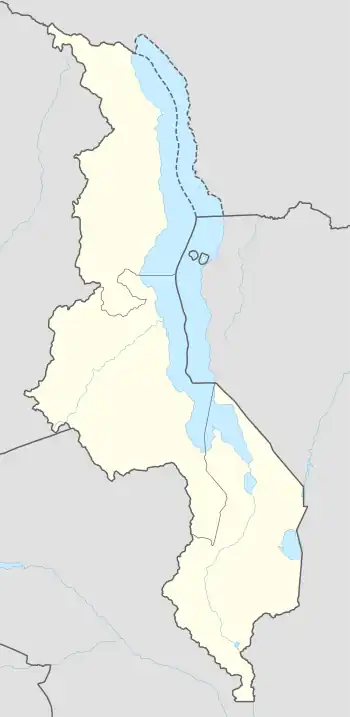| Ruo–Ndiza Hydroelectric Power Station | |
|---|---|
 Location of Ruo–Ndiza Hydroelectric Power Station in Malawi | |
| Country | Malawi |
| Location | Mulanje, |
| Coordinates | 16°05′25″S 35°39′53″E / 16.09028°S 35.66472°E |
| Purpose | Power |
| Status | Operational |
| Operator(s) | Mulanje Hydro Limited |
| Dam and spillways | |
| Impounds | Confluence of Ruo River and Ndiza River |
| Turbines | Pelton turbine 2 x 3.30 MW (4,430 hp) 1 x 1.65 MW (2,210 hp) |
| Installed capacity | 8.25 MW (11,060 hp) |
The Ruo–Ndiza Hydroelectric Power Station is an operational 8.25 megawatts (11,063 hp) hydroelectric power plant in southeastern Malawi, at the border with Mozambique.[1]
Location
The power station is located across the confluence of the Ruo River and its tributary, the Ndiza River, in Mulanje District, in the Southern Region of Malawi, at the international border with the Republic of Mozambique.[2]
The location is within the Lujeri Tea Estate, approximately 96 kilometres (60 mi), by road, southeast of Blantyre, the commercial and financial capital of Malawi.[2][3]
Overview
In March 2018, Malawi's installed electricity-generating capacity was 363 megawatts (487,000 hp),[4] With peak demand of 350 megawatts and growing at about 6 percent annually, the Malawian grid has very little flexibility. This has exposed the country to severe, recurrent load-shedding.[5]
Mulanje Renewable Energy Plc (also Mulanje Hydro Limited), a private energy-generating company, domiciled in Malawi, contracted Gilkes, a British electric turbine manufacturer to build this power station, over a two-year period.[6]
Technical details
The power station is a run-of-river design which does not require a dam and therefore no need for a reservoir. There are three Pelton-type turbines each rated at 3.30 megawatts (4,425 hp). One was installed on the Ndizi River, during the first phase. Due to the water flow rates on this small river, only 1.65 megawatts could be extracted.[1] [2][6]
The second phase included the installation of two more Pelton turbines each rated at 3.3 megawatts, across the Ruo River, yielding a total of 6.6 megawatts in new energy generation. The total output of the power complex is 8.25 megawatts.[1][2][6]
Construction
The construction budget has been reported at US$16 million. Construction began in June 2018 and concluded in April 2020. The power generated is sold to the national power distributor Electricity Supply Commission of Malawi (Escom), under a long-term power purchase agreement.[7]
See also
References
- 1 2 3 Jean Marie Takouleu (2 May 2020). "Malawi: Gilkes completes second phase of Ruo-Ndiza hydroelectric project". Paris, France: Afrik21.africa. Retrieved 9 May 2020.
- 1 2 3 4 Water Power Magazine (28 April 2020). "Gilkes commissions African project, receives new order". Dartford, Kent, United Kingdom: Waterpowermagazine.com. Retrieved 9 May 2020.
- ↑ Google (9 May 2020). "Road Distance Between Blantyre And Lujeri Tea Estate" (Map). Google Maps. Google. Retrieved 9 May 2020.
- ↑ USAID (28 March 2018). "Malawi: Power Africa Fact Sheet". Washington, DC: United States Agency for International Development (USAID). Retrieved 9 May 2020.
- ↑ Marcel Chimwala (23 May 2014). "Chinese bank looks to finance Malawi power station". Johannesburg: Engineeringnews.co.za. Retrieved 9 May 2020.
- 1 2 3 Lloyd M’bwana (27 February 2019). "Malawi's Mulanje US$16 million power plant to roll out March" (Quoting The Maravi Post). Energycentral.com. Retrieved 8 May 2020.
- ↑ Elijah Phimbi (26 February 2019). "$16 Million Power Project On Course In Mulanje: To Supply Electricity To Escom From March". Nyasa Times. Blantyre. Retrieved 9 May 2020.